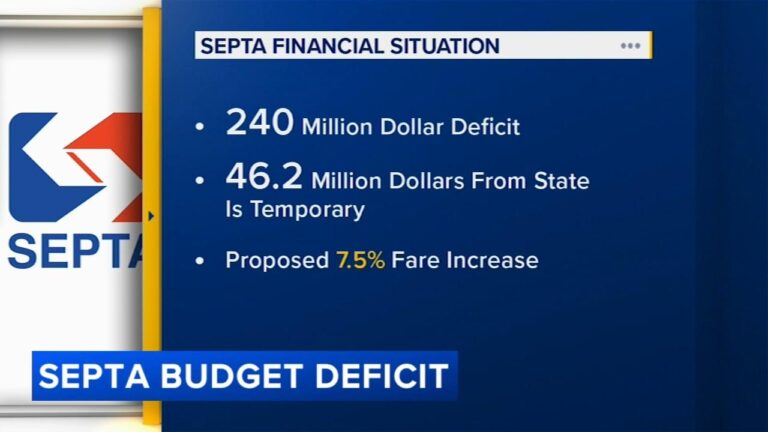Philadelphia’s SEPTA Faces Financial Crisis: Implications for Transit and Community
Financial Challenges Jeopardize SEPTA’s Vital Transit Services
The Southeastern Pennsylvania Transportation Authority (SEPTA) is currently grappling with a severe budget deficit that threatens to disrupt essential public transit services throughout the Philadelphia metropolitan area. This fiscal shortfall raises alarms among daily commuters and local enterprises alike, as potential service reductions could significantly affect accessibility and convenience. Thousands of residents who depend on SEPTA for commuting to work, school, and other critical activities are concerned about the prospect of diminished service reliability and availability.
Areas most vulnerable to cuts include:
- Scaling back weekend and nighttime transit operations
- Discontinuation of underutilized bus lines
- Fare increases aimed at bridging budget gaps
| Proposed Reductions | Consequences for Passengers |
|---|---|
| Elimination of nearly one-third of bus routes | Extended waiting periods and reduced transit access in suburban neighborhoods |
| 15% increase in fare prices | Heightened financial strain on economically vulnerable populations |
| Lower frequency of rail services | Overcrowded trains and inconsistent schedules during rush hours |
Voices from the Community: Concerns Over Daily Life and Local Economy
Residents and regular SEPTA users are voicing strong apprehension about the proposed service reductions, emphasizing the potential disruption to their daily routines. Many households rely on SEPTA for essential travel, including commuting to workplaces, attending schools, and managing healthcare appointments. Service cuts could lead to longer travel times, overcrowded vehicles, and increased transportation expenses, placing additional burdens on families already managing tight schedules.
Local business owners also warn of the economic repercussions. Small retailers and service providers depend heavily on the accessibility that SEPTA offers to maintain steady customer flow and employee attendance. A decline in transit availability could translate into fewer shoppers and workforce challenges, exacerbating financial difficulties in an already fragile economic environment.
- Longer commutes anticipated for thousands of riders
- Potential job instability due to reduced customer and employee access
- Increased pressure on families balancing work, childcare, and education
| Group Affected | Likely Outcomes |
|---|---|
| Commuters | Longer wait times and higher travel costs |
| Businesses | Decline in customer visits and revenue |
| Families | Scheduling difficulties and increased expenses |
Broader Economic Consequences of Shrinking Transit Services
The ripple effects of SEPTA’s potential service reductions extend beyond individual riders, threatening the economic vitality of the Philadelphia region. Reduced transit options could force many residents to seek costlier or less efficient transportation alternatives, straining household budgets. Small businesses, which often rely on SEPTA for both customer access and employee commutes, may experience decreased patronage and operational challenges, potentially leading to layoffs or closures.
Moreover, a shift away from public transit could increase automobile traffic, contributing to congestion and environmental degradation. This scenario risks exacerbating economic disparities, as low-income communities—who disproportionately depend on affordable transit—would bear the brunt of these changes.
- Decreased job accessibility: Limited transit routes may hinder timely employee commutes.
- Revenue losses for businesses: Fewer customers due to reduced transit connectivity.
- Higher household transportation costs: Families forced to use more expensive travel options.
- Increased traffic and pollution: More cars on roads leading to environmental and logistical challenges.
| Sector | Immediate Impact | Long-Term Risk |
|---|---|---|
| Employment | Delays in commuting | Reduced job accessibility |
| Small Businesses | Decline in customer traffic | Revenue loss and potential closures |
| Households | Increased transit expenses | Greater financial hardship |
| Environment | More vehicles on roads | Higher pollution levels |
Calls for Action: Funding and Innovation to Sustain SEPTA Services
Community advocates, business leaders, and policymakers are urging increased investment and creative strategies to prevent drastic service cuts at SEPTA. As ridership gradually rebounds following the COVID-19 pandemic, stakeholders emphasize the importance of maintaining affordable and reliable transit, especially for low-income populations who depend on it for essential mobility.
Proposed measures to stabilize SEPTA’s finances and improve service include:
- Expanding targeted grants to preserve critical transit routes
- Introducing regional transportation levies to generate consistent funding
- Leveraging technology to enhance operational efficiency and reduce costs
- Fostering transparent collaboration among stakeholders to prioritize service needs
| Stakeholder | Main Concern | Recommended Approach |
|---|---|---|
| Transit Riders | Preservation of essential routes | Safeguard core services and boost funding |
| Local Businesses | Maintaining customer access | Improve transit connectivity and reliability |
| Government Officials | Addressing budget deficits | Secure new revenue sources and grants |
Conclusion: Balancing Fiscal Responsibility with Community Needs
As SEPTA confronts a looming budget deficit that could lead to substantial service reductions, the concerns raised by riders and local businesses highlight the indispensable role of public transportation in the Philadelphia region. Reliable transit is a lifeline for families, enabling access to employment, education, and essential services, while also underpinning the local economy by facilitating customer and employee mobility. Moving forward, it is imperative for city leaders and stakeholders to collaborate on sustainable funding and innovative solutions that preserve SEPTA’s vital services, ensuring equitable mobility and economic resilience for the region.








